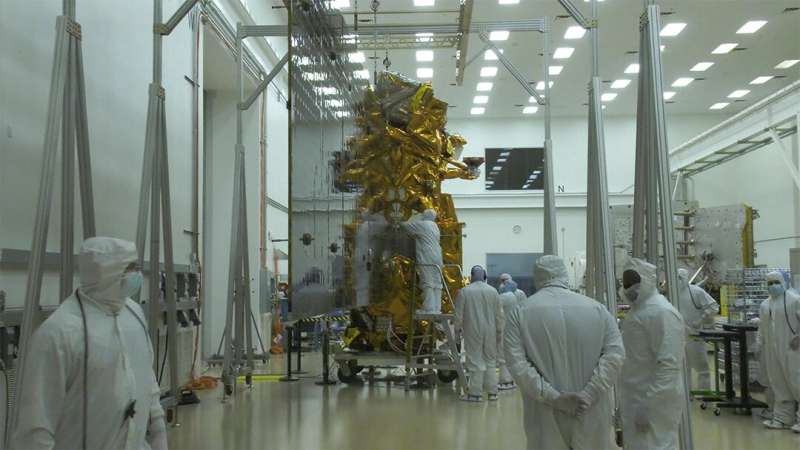Solar array installed on JPSS-2 satellite

On July 26, in a clean room at the Northrop Grumman facility in Gilbert, Arizona, the National Oceanic and Atmospheric Administration's Joint Polar Satellite System-2 (JPSS-2) let out several loud pops as each of the five panels of its solar array detached from the body of the satellite and then unfolded, stretching out to its full 30-foot length. Under each panel, an engineer clad in a bunny suit flashed a thumbs up as latches clicked into place.
The deployment of the solar array, which had been installed three days earlier, marked the last major testing milestone of the weather satellite. JPSS-2 has now been boxed up and will be shipped to the Vandenberg Space Force Base in California for its Nov. 1 launch. The next time the solar array deploys will be in space.
"This is a culmination of seven years of work on this program," said Scott Capehart, JPSS program director at Northrop Grumman Corporation, where the spacecraft is built and tested. "Its success establishes that we're ready for launch."
Once launched, the JPSS-2 satellite, like its predecessors Suomi-NPP and NOAA-20, will race around Earth from pole to pole, taking measurements and snapping images that help us plan for hurricanes, snowstorms, floods, and other severe weather. The satellite will feed critical data to global weather forecast models.
"During stressful times, like running into an issue at the end of a long overnight shift, I always come back to the impact that JPSS-2 will have," said Adelina Nastasoiu, an instrument systems engineer at Northrop Grumman. "The weather models it's going to affect, the lives it's going to save, and that it shares data freely with the entire world."
JPSS-2 will also measure our oceans and atmosphere, map and monitor volcanoes and wildfires and tell us about the things that fill our air and lungs, like dust and smoke. Because of its wide swath, it will observe every spot on Earth at least twice a day.
In the clean room in Gilbert, the satellite sat upright, mounted on a rack on wheels. Multi-layered insulation resembling gold tinfoil blanketed the body of the spacecraft. Covers with "Remove before flight" signs protected each of its four instruments.
About 20 feet away, engineers checked connections and voltage on the spacecraft for JPSS-3, the next satellite in line to launch. And packed in boxes and stacked on wire shelves at the back of the clean room were the parts for JPSS-4, the final satellite in the JPSS series. Combined, the three satellites are expected to provide data into the 2030s.
Together, NASA and NOAA oversee the development, launch, testing, and operation of all the satellites in the JPSS program. NOAA funds and manages the program, operations, and data products. On behalf of NOAA, NASA develops and builds the instruments, spacecraft, and ground system, and launches the satellites, which NOAA operates.
Provided by NASA's Goddard Space Flight Center




















